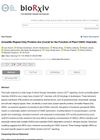
Search
for
Sort by
Research
270-300 / 530 results

research Redox-Directed Interventions Targeting Skin Photodamage
Some treatments can improve skin's defense against damage, but overuse may cause other skin problems.

research Abstracts from the ASA 40th Annual Meeting
HNG may help prevent the negative effects of chemotherapy on sperm production and white blood cell counts.

research Chemicals and Stem Cells in the Promotion of Regeneration
Chemicals and stem cells combined have advanced regenerative medicine with few safety concerns, focusing on improving techniques and treatment effectiveness.

research Effects of Parthenolide on Androgenetic Alopecia in Mice and Human Follicle Dermal Papilla Cells
Parthenolide promotes hair growth in mice and may influence pathways related to male pattern baldness.

research British Society for Dermatopathology: Summaries of Papers
Some skin conditions are associated with other serious diseases, and office microscopy may miss many fungal infections.

research Ionizing Radiation Triggers Dedifferentiation of Outer Root Sheath Cells Into Stem Cell-Like Progenitors for Hair Follicle Regeneration
research Type XVII Collagen Coordinates Proliferation in the Interfollicular Epidermis
Type XVII collagen helps control skin cell growth and could be a target for anti-aging treatments.

research In Silico Structural Prediction of Human Steroid 5α-Reductase Type II
Scientists found out the structure of a human enzyme linked to prostate cancer and hair loss, which could help in designing drugs.

research Logic-Based Modeling and Drug Repurposing for the Prediction of Novel Therapeutic Targets and Combination Regimens Against E2F1-Driven Melanoma Progression
Tadalafil and Finasteride may help treat aggressive melanoma.

research Spatial Transcriptomics of a Giant Pilomatricoma
The analysis of a large pilomatricoma revealed five distinct areas with different gene activity related to hair growth and tumor development.
research Exosomes Derived from Dermal Papilla Cells Mediate Hair Follicle Stem Cells Proliferation Through the Wnt3a/β-Catenin Signaling Pathway
Exosomes from dermal papilla cells help hair stem cells grow through a specific signaling pathway.
research Upregulation of SERPINB3/B4 and S100A7-9 in Hidradenitis Suppurativa/Acne Inversa
Certain proteins are significantly increased in the skin of people with hidradenitis suppurativa.
research Finasteride Induces Epigenetic Modulation of LSP1: A Gene Implicated in Neutrophil Actin Dysfunction Disease
Finasteride may help treat Neutrophil Actin Dysfunction by reducing LSP1 gene activity.
research BMP Signaling in the Control of Skin Development and Hair Follicle Growth
BMP signaling is crucial for skin and hair growth.
research Epidermal Growth Factor Receptor Inhibitors: A Review of Cutaneous Adverse Events and Management
Skin side effects from cancer drugs targeting EGFR can affect treatment adherence but can be managed with antibiotics like tetracycline.
research The Roles of Autophagy and Apoptosis in Burn Wound Progression in Rats
Treatments for burn wounds in rats should be timed according to whether autophagy or apoptosis is more active at certain times after the burn.
research Localization of Plasminogen Activator Inhibitor Type 2 in Hair and Nail: Implications for Terminal Differentiation
PAI-2 helps in the maturation and protection of hair and nail cells.
research Dupilumab And Alopecia: A Janus Effect
Dupilumab can both heal and cause hair loss.
research Scd1 ab-Xyk: A New Asebic Allele Characterized by a CCC Trinucleotide Insertion in Exon 5 of the Stearoyl-CoA Desaturase 1 Gene in Mouse
A new mouse mutation causes skin and hair defects due to a gene change.
research TGF-β2 and Collagen Play Pivotal Roles in the Spheroid Formation and Anti-Aging of Human Dermal Papilla Cells
Collagen and TGF-β2 help maintain hair cell shape and youthfulness.
research DNMT1-Mediated Methylation Inhibits MicroRNA-214-3p and Promotes Hair Follicle Stem Cell Differentiation Into Adipogenic Lineages
DNMT1 helps turn hair follicle stem cells into fat cells by blocking a specific microRNA.
research Platelet-Rich Plasma in Dermatology: Cellular and Molecular Mechanisms of Action
PRP therapy helps skin heal and improve by promoting cell growth and repair.
research Ficus Benghalensis as Potential Inhibitor of 5α-Reductase for Hair Growth Promotion: In Vitro, In Silico, and In Vivo Evaluation
Ficus benghalensis leaf extracts can effectively promote hair growth and inhibit hair loss.
research The Stem Cell Quiescence and Niche Signaling Is Disturbed in the Hair Follicle of the Hairpoor Mouse, an MUHH Model Mouse
Disrupted stem cell signals in hairpoor mice cause hair loss.

research Efficacy and Safety of Topical Rosuvastatin and Melatonin vs. Placebo in Patients with Mild to Moderate Plaque Psoriasis: A Preliminary Randomized Double-Blinded Clinical Trial
Topical rosuvastatin and melatonin creams significantly reduce psoriasis severity and are safe.

research Expression Level of Leucine-Rich Repeat Containing 15 Regulates Characteristics of Dermal Papilla Cells of Human Hair Follicle
The gene LRRC15 is more active in balding areas of the scalp compared to non-balding areas.

research Screening of Anti-Hair Loss Plant Raw Materials Based on Reverse Network Pharmacology and Experimental Validation
Certain plant extracts may help prevent hair loss and promote hair growth safely.

research Armadillo Repeat Only Proteins Are Crucial for the Function of Plant CNGC Channels
Armadillo Repeat Only proteins are essential for proper plant growth and response by regulating calcium channels.

research Melatonin Promotes Hair Regeneration by Modulating the Wnt/β-Catenin Signaling Pathway
Melatonin helps hair grow by activating a specific signaling pathway.